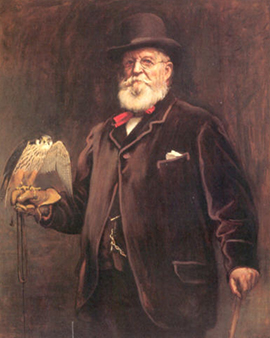It is said that Joseph Wolf (1820-1899), the farmer's son from the Eifel, painted in Terra Nullius between art and science. He filled this segment completely with his works and thus he is consistently considered the most important artist in his field.
In addition, the painter is one of those personalities who are not so easily labelled - but individualists are sometimes treated stepmotherly by historians. Thus Joseph Wolf initially took part in scientific progress only as a painter whose task it was to illustrate the work of others, and although he was respected in the artistic circles of his time, he had no influence of his own and no successor. Rather, Wolf's paintings were regarded as somewhat too scientific by artists and somewhat too artistic by scientists. Ultimately, the invention of photography also caused a certain disenchantment with his lifelike images. But later his paintings often reported about the drama in nature.
Joseph Wolf possessed an "absolute eye". He roamed the native forests and meadows to chase foxes, wild boars and birds of prey. In the evening he made sketches of his observations from memory. Later, his father sent him to Constance: Joseph Wolf completed an apprenticeship as a printer there, after which he went to the Grand Ducal Natural History Cabinet in Darmstadt. The director of the cabinet then recommended him further as an illustrator for zoologists and researchers. According to this, Joseph Wolf was able to illustrate the important falcon book Traité de Fauconnerie by the zoologist Schlegel - the twelve photographically accurate lithographs are regarded as the basis of his career as an animal illustrator.
There was enough work: new species of animals came to Europe from the colonial countries at that time and had to be drawn in detail for the destination books. Among other works, Joseph Wolf also drew the illustrations for the fauna Japonica by Franz von Siebold, thus furthering the progress in zoology of his time.
Joseph Wolf went to London in 1848. Up to the end of his life he remained in the hotspot of natural history. Studies in the big zoos of London with a lot of exotic animals strengthened his artistic reputation. Additionally, he published in scientific magazines. At the latest after Joseph Wolf had created the first lifelike representation of gorillas, which shaped the image of the great ape species over decades, his great reputation was complete. In addition to Wolf's feeling for the behaviour and movement of the animals, his works crystallized an increasing overall ecological understanding.
His heart always hung on his own observations, day and night. In the process, he produced detailed sketches and studies that often served the zoological sciences as a basis for further research. When he found it difficult to produce such detailed small formats with increasing age, Joseph Wolf devoted himself more and more to animal painting.
Instead of small scientific formats, the artist produced paintings that told of the struggle for survival in nature - Charles Darwin had characterized this struggle as the "motor of evolution". Wolf had sympathies with the inferior and weak, so his precise and distanced observations of nature were replaced by paintings full of poetically painted love of animals.
Ultimately, Wolf's artistic work is considered to be far more significant than photographic snapshots, because they are the result of the most intensive study of the biology of animals.
×





.jpg)
.jpg)
.jpg)
.jpg)
 1856-67 (wc pencil on - (MeisterDrucke-226676).jpg)
 1856-67 (wc pencil on - (MeisterDrucke-226676).jpg)
 1856 - (MeisterDrucke-183964).jpg)
 1856 - (MeisterDrucke-183964).jpg)
 c1850 - (MeisterDrucke-191923).jpg)
 c1850 - (MeisterDrucke-191923).jpg)
_1856-67_-_(MeisterDrucke-310968).jpg)
_1856-67_-_(MeisterDrucke-310968).jpg)
.jpg)
.jpg)
.jpg)
.jpg)
.jpg)
.jpg)
_-_(MeisterDrucke-1654777).jpg)
_-_(MeisterDrucke-1654777).jpg)
_-_(MeisterDrucke-1654424).jpg)
_-_(MeisterDrucke-1654424).jpg)
_-_(MeisterDrucke-1655246).jpg)
_-_(MeisterDrucke-1655246).jpg)
_-_(MeisterDrucke-1654432).jpg)
_-_(MeisterDrucke-1654432).jpg)
_-_(MeisterDrucke-1653830).jpg)
_-_(MeisterDrucke-1653830).jpg)
_-_(MeisterDrucke-1653743).jpg)
_-_(MeisterDrucke-1653743).jpg)
_-_(MeisterDrucke-1654419).jpg)
_-_(MeisterDrucke-1654419).jpg)
_-_(MeisterDrucke-1655241).jpg)
_-_(MeisterDrucke-1655241).jpg)
_-_(MeisterDrucke-1653831).jpg)
_-_(MeisterDrucke-1653831).jpg)
_-_(MeisterDrucke-1654425).jpg)
_-_(MeisterDrucke-1654425).jpg)
_-_(MeisterDrucke-1653515).jpg)
_-_(MeisterDrucke-1653515).jpg)
_-_(MeisterDrucke-1654426).jpg)
_-_(MeisterDrucke-1654426).jpg)
_-_(MeisterDrucke-1653832).jpg)
_-_(MeisterDrucke-1653832).jpg)
_-_(MeisterDrucke-1655242).jpg)
_-_(MeisterDrucke-1655242).jpg)
_-_(MeisterDrucke-1655235).jpg)
_-_(MeisterDrucke-1655235).jpg)
_-_(MeisterDrucke-1653834).jpg)
_-_(MeisterDrucke-1653834).jpg)
_-_(MeisterDrucke-1653744).jpg)
_-_(MeisterDrucke-1653744).jpg)
.jpg)
.jpg)
_-_(MeisterDrucke-1653742).jpg)
_-_(MeisterDrucke-1653742).jpg)
.jpg)
.jpg)
.jpg)
.jpg)
.jpg)
.jpg)
_-_(MeisterDrucke-1654859).jpg)
_-_(MeisterDrucke-1654859).jpg)
.jpg)
.jpg)
.jpg)
.jpg)
_-_(MeisterDrucke-1654420).jpg)
_-_(MeisterDrucke-1654420).jpg)
.jpg)
.jpg)
_-_(MeisterDrucke-1653518).jpg)
_-_(MeisterDrucke-1653518).jpg)
 1856-67 - (MeisterDrucke-301181).jpg)
 1856-67 - (MeisterDrucke-301181).jpg)
.jpg)
.jpg)
_-_(MeisterDrucke-1653748).jpg)
_-_(MeisterDrucke-1653748).jpg)
.jpg)
.jpg)
_-_(MeisterDrucke-1654433).jpg)
_-_(MeisterDrucke-1654433).jpg)
_-_(MeisterDrucke-1654854).jpg)
_-_(MeisterDrucke-1654854).jpg)
_-_(MeisterDrucke-1655245).jpg)
_-_(MeisterDrucke-1655245).jpg)
.jpg)
.jpg)
.jpg)
.jpg)
.jpg)
.jpg)
_-_(MeisterDrucke-1653833).jpg)
_-_(MeisterDrucke-1653833).jpg)
_-_(MeisterDrucke-1655240).jpg)
_-_(MeisterDrucke-1655240).jpg)
.jpg)
.jpg)
.jpg)
.jpg)
.jpg)
.jpg)
_-_(MeisterDrucke-1653516).jpg)
_-_(MeisterDrucke-1653516).jpg)
.jpg)
.jpg)
 1852-54 - (MeisterDrucke-218518).jpg)
 1852-54 - (MeisterDrucke-218518).jpg)
 1852-54 - (MeisterDrucke-236033).jpg)
 1852-54 - (MeisterDrucke-236033).jpg)
 c1851-76 (wc pencil on pape - (MeisterDrucke-252407).jpg)
 c1851-76 (wc pencil on pape - (MeisterDrucke-252407).jpg)
.jpg)
.jpg)
 1852-54 - (MeisterDrucke-190303).jpg)
 1852-54 - (MeisterDrucke-190303).jpg)
.jpg)
.jpg)
 1856-67 - (MeisterDrucke-214841).jpg)
 1856-67 - (MeisterDrucke-214841).jpg)
.jpg)
.jpg)
_-_(MeisterDrucke-1653747).jpg)
_-_(MeisterDrucke-1653747).jpg)
_-_(MeisterDrucke-1654858).jpg)
_-_(MeisterDrucke-1654858).jpg)
 1852 - (MeisterDrucke-279171).jpg)
 1852 - (MeisterDrucke-279171).jpg)
.jpg)
.jpg)
.jpg)
.jpg)
 1852-54 - (MeisterDrucke-145155).jpg)
 1852-54 - (MeisterDrucke-145155).jpg)
.jpg)
.jpg)
.jpg)
.jpg)
.jpg)
.jpg)
.jpg)
.jpg)
 1852-54 - (MeisterDrucke-234925).jpg)
 1852-54 - (MeisterDrucke-234925).jpg)
 1852-54 - (MeisterDrucke-254793).jpg)
 1852-54 - (MeisterDrucke-254793).jpg)
.jpg)
.jpg)
.jpg)
.jpg)
.jpg)
.jpg)
 1852-54 - (MeisterDrucke-237543).jpg)
 1852-54 - (MeisterDrucke-237543).jpg)
.jpg)
.jpg)
 1867 (wc pencil o - (MeisterDrucke-228843).jpg)
 1867 (wc pencil o - (MeisterDrucke-228843).jpg)
.jpg)
.jpg)
.jpg)
.jpg)
.jpg)
.jpg)
 1856-67 - (MeisterDrucke-217171).jpg)
 1856-67 - (MeisterDrucke-217171).jpg)
 c1851-76 (wc pencil o - (MeisterDrucke-278264).jpg)
 c1851-76 (wc pencil o - (MeisterDrucke-278264).jpg)
.jpg)
.jpg)
.jpg)
.jpg)
.jpg)
.jpg)
.jpg)
.jpg)
.jpg)
.jpg)
 - (MeisterDrucke-256449).jpg)
 - (MeisterDrucke-256449).jpg)
.jpg)
.jpg)
_-_(MeisterDrucke-1172445).jpg)
_-_(MeisterDrucke-1172445).jpg)
 c1851-76 - (MeisterDrucke-236584).jpg)
 c1851-76 - (MeisterDrucke-236584).jpg)
.jpg)
.jpg)
.jpg)
.jpg)
 1869 - (MeisterDrucke-171470).jpg)
 1869 - (MeisterDrucke-171470).jpg)
.jpg)
.jpg)
.jpg)
.jpg)
_-_(MeisterDrucke-549213).jpg)
_-_(MeisterDrucke-549213).jpg)






